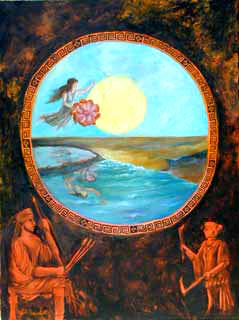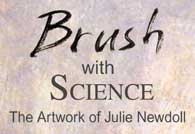
shows the artwork of
Julie Newdoll
September 17 - October 30
Reception October 22, 2:00 - 4:00
 View Portfolio |
 Inside Time |
 Shows |
 About/Contact the Artist |
Brush with Science - the Artwork of
Julie NewdollThe New York Hall of Science will display a selection of work from four series by Julie Newdoll this fall. I hope to see you at the reception!
Works which belong in the collection of the artist are for sale. Prints are in stock for many pieces. Contact Julie Newdoll for details.
|
Plato Dreaming, Cell Dividing The goddess of cell division uses her spinning wheel to guide the events which cause a mother cell to split into two daughter cells. |
Life Forms Human figures engaged in a "dance of the molecules", pushing, pulling, and interacting with each other like the tiny building blocks that make up the structures critical to our being. |
|
Kimonos of the Senses for a Japanese Tea Ceremony The Japanese Tea Ceremony emphasizes the use of all of the senses for the people participating. Five paintings of kimonos, one for each sense, use seductive imagery from the cells and organs which receive each sense in their design. |
Nanotechnology What seemed like imaginative congecture in the early 1990's may occur in our lifetime. These paintings on the science of building machines out of atoms, called "Nanotechnology", incorporate the first types of structures built as a proof of concept that it could be done. |
| Plato Dreaming, Cell Dividing #1; (Prophase), oil on canvas, 3' x 4', 2005 Collection of the Artist, $5,700 framed The division of the cell made life possible. In order to produce offspring, an organism must be able to self-replicate. Without cell division, there would be no multicellular organisms. Cell division is the primary life cycle. |
|
| Plato Dreaming, Cell Dividing #2; (Metaphase) oil on canvas 3' x 4' 2005 Collection of the Artist, $5,700 framed Ananke was a weaver, goddess of necessity and mother of the fates. In Plato's dream, she spins threads out from her spinning wheel in the sky, and sends them down to capture and reel in souls standing on earth. Her threads are like the microtubule fibres that are created when a cell divides. They grow from the centers of activity, one on each side of the cell, and attach to chromosomes lined up at the center. Each half of the cell will get its own set of chromosomes. The setting sun symbolizes the degrading nucleus, which disappears during the cell division process. |
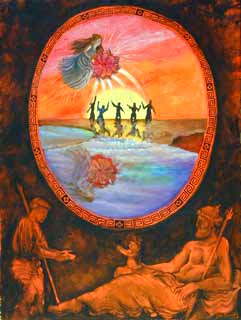 |
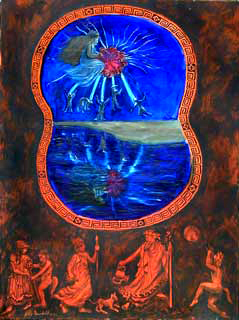 |
Plato Dreaming, Cell Dividing #3; (Anaphase) oil on canvas 3' x 4' 2005 Collection of the Artist, $5,700 framed The goddess of cell division is now reeling up souls into the sky, like chromosomes would be drawn to the sides of a dividing cell. The cell is becoming pinched at the middle, in preparation for division into two separate cells. A scene from the life of Dionysus is pictured across the bottom. His female companions will soon rip his likeness into pieces in their frenzy. |
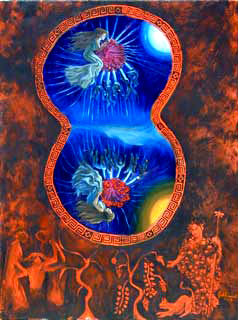 |
Plato Dreaming, Cell Dividing #4; (Late Anaphase) oil on canvas 3' x 4' 2005 Collection of the Artist, $5,700 framed The souls (chromosomes) are now at the opposite ends of the cell - a set for each side. The nuclei are returning, appearing as the rising moon and sun. As the cell rips apart, it pinches dramatically at the waist. A scene from the death of Dionysus is pictured across the bottom left. An image symbolizing his eventual rebirth, Dionysus as a bunch of grapes, is on the right. |
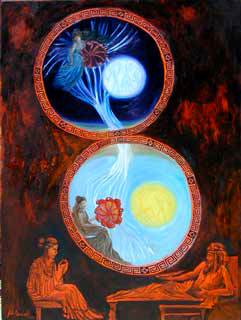
|
Plato Dreaming, Cell Dividing #5; (Telophase) oil on canvas 3' x 4' 2005 Collection of the Artist, $5,700 framed The cell has now divided into two cells. Across the bottom, Persephone is picture with Hades. The divided cell reflects her thoughts of living in two different worlds. |
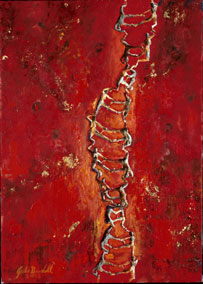 |
The Life Forms Series
Dawn of the Double Helix This one will be an enhanced digital print. The owner of the original could not be reached. |
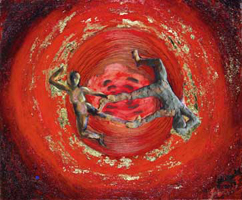 |
Base Pair oil/mixed media 18" x 24" 2003 Collection of Dr. Sam Dychter |
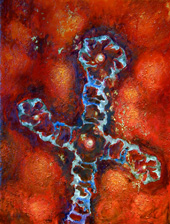 |
RNA in a Modern World oil/mixed media 24" x 33" 2003 Collection of the Artist, $2,600 framedo |
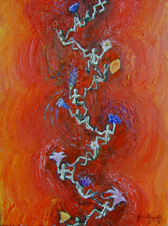 |
Rise of the Alpha Helix oil/mixed media 18" x 24" 2003 Collection of Drs. Devavani Chatterjea and David Matthes |
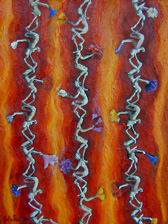 |
Figures in a Beta Sheet oil/mixed media 18" x 24" 2003 Collection of Drs. Devavani Chatterjea and David Matthes |
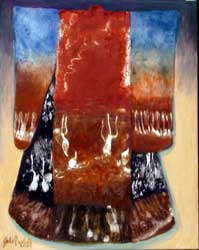 |
Kimonos of the Senses for a Japanese Tea Ceremony Sense of Taste Kimono oil/mixed media 36" x 42" 2005 Collection of the Artist, $5,300 framed |
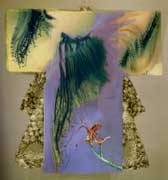 |
Sense of Smell Kimono oil/mixed media 36" x 42" 2005 Collection of the Artist, $5,300 framed |
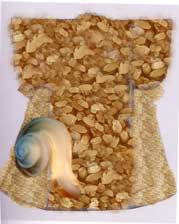 |
Sense of Hearing Kimono oil/mixed media 36" x 42" 2005 Collection of the Artist, $5,300 framed |
 |
Sense of Hearing Kimono oil/mixed media 36" x 42" 2005 Collection of the Artist, $5,300 framed |
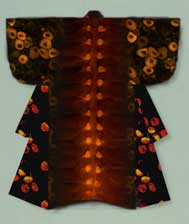 |
Sense of Hearing Kimono oil/mixed media 36" x 42" 2005 Collection of the Artist, $5,300 framed |
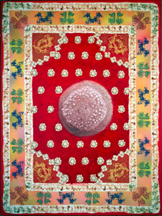 |
A Taste of India oil/mixed media 36" x 42" 2004 Collection of the Artist, $5,300 framed |
 |
Three paintings on Nanotechnology Nanotechnology I oil/mixed media 20" x 24" 2005 Collection of Dr. Chris Cullander |
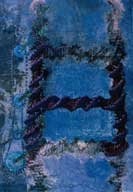 |
Nanotechnology II oil/mixed media 3' x 4' 1992 Collection of Mr. and Mrs. Newdoll |
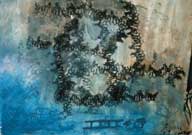 |
Nanotechnology III oil/mixed media 20" x 24" 1992 Collection of Dr. Nadrian Seeman |
